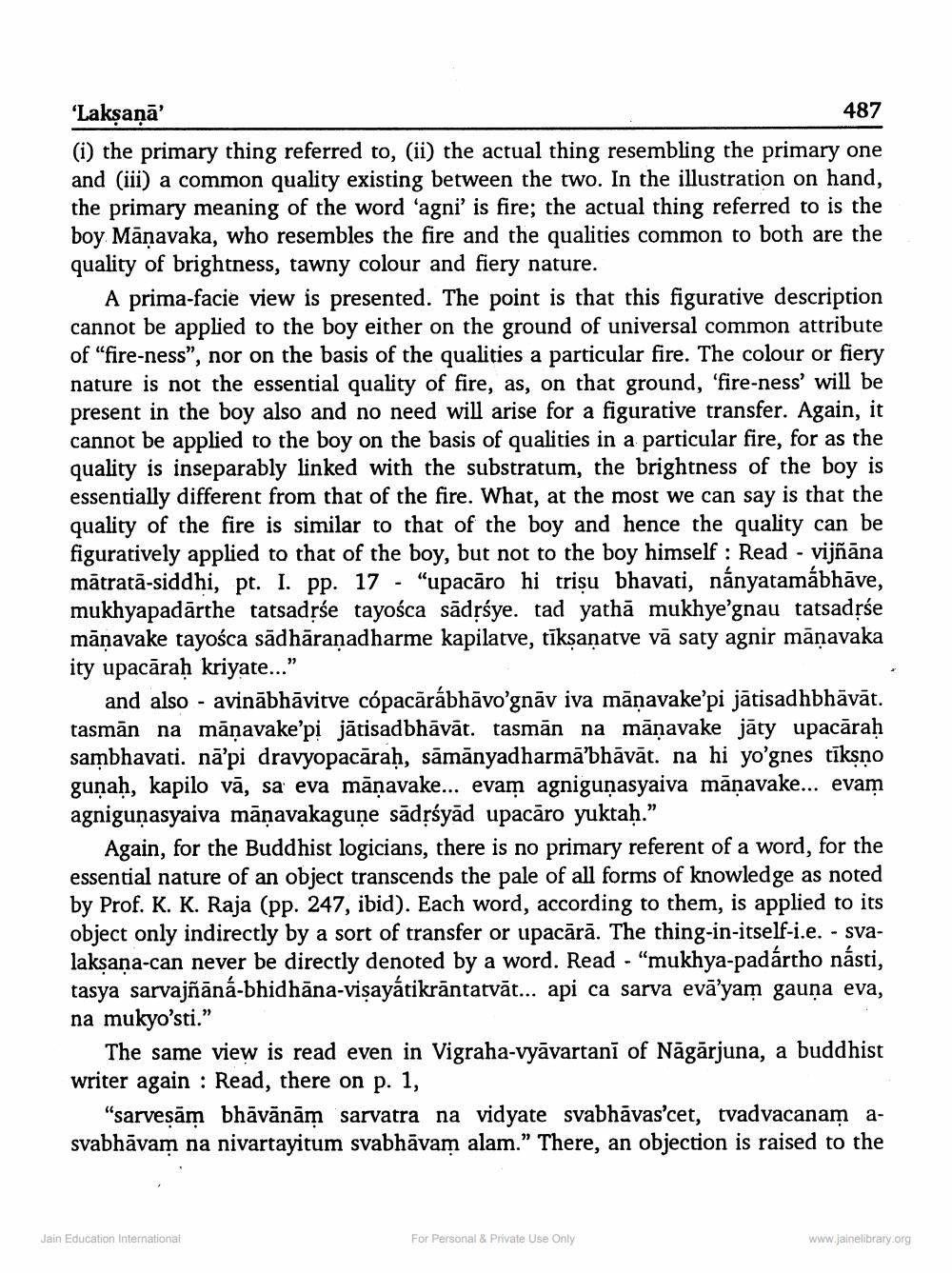________________
'Laksanā'
487 (i) the primary thing referred to, (ii) the actual thing resembling the primary one and (iii) a common quality existing between the two. In the illustration on hand, the primary meaning of the word 'agni' is fire; the actual thing referred to is the boy Mänavaka, who resembles the fire and the qualities common to both are the quality of brightness, tawny colour and fiery nature.
A prima-facie view is presented. The point is that this figurative description cannot be applied to the boy either on the ground of universal common attribute of "fire-ness", nor on the basis of the qualities a particular fire. The colour or fiery nature is not the essential quality of fire, as, on that ground, 'fire-ness' will be present in the boy also and no need will arise for a figurative transfer. Again, it cannot be applied to the boy on the basis of qualities in a particular fire, for as the quality is inseparably linked with the substratum, the brightness of the boy is essentially different from that of the fire. What, at the most we can say is that the quality of the fire is similar to that of the boy and hence the qu figuratively applied to that of the boy, but not to the boy himself : Read - vijñāna mātratā-siddhi, pt. I. pp. 17 - "upacāro hi trișu bhavati, nányatamábhāve, mukhyapadārthe tatsadrśe tayośca sādņśye. tad yathā mukhye’gnau tatsadệśe māņavake tayośca sādhāraṇadharme kapilatve, tīkṣaṇatve vā saty agnir māņavaka ity upacāraḥ kriyate...”
and also - avinābhāvitve cópacārabhāvo'gnāv iva māņavake’pi jātisadhbhāvāt. tasmān na mānavake'pi jātisadbhāvāt. tasmān na mānavake jāty upacārah sambhavati. nā’pi dravyopacāraḥ, sāmānyadharmā’bhāvāt. na hi yo'gnes tīksno guṇaḥ, kapilo vā, sa eva māņavake... evam agniguṇasyaiva māņavake... evam agniguṇasyaiva māņavakagune sădrśyād upacāro yuktah.”
Again, for the Buddhist logicians, there is no primary referent of a word, for the essential nature of an object transcends the pale of all forms of knowledge as noted by Prof. K. K. Raja (pp. 247, ibid). Each word, according to them, is applied to its object only indirectly by a sort of transfer or upacārā. The thing-in-itself-i.e. - svalaksana-can never be directly denoted by a word. Read - “mukhya-padártho násti, tasya sarvajñāná-bhidhāna-visayatikrāntarvāt... api ca sarva evā’yam gauņa eva, na mukyo'sti."
The same view is read even in Vigraha-vyāvartanī of Nāgārjuna, a buddhist writer again : Read, there on p. 1,
"sarvesām bhāvānām sarvatra na vidyate svabhāvas'cet, tvadvacanam asvabhāvam na nivartayitum svabhāvam alam.” There, an objection is raised to the
Jain Education International
For Personal & Private Use Only
www.jainelibrary.org




